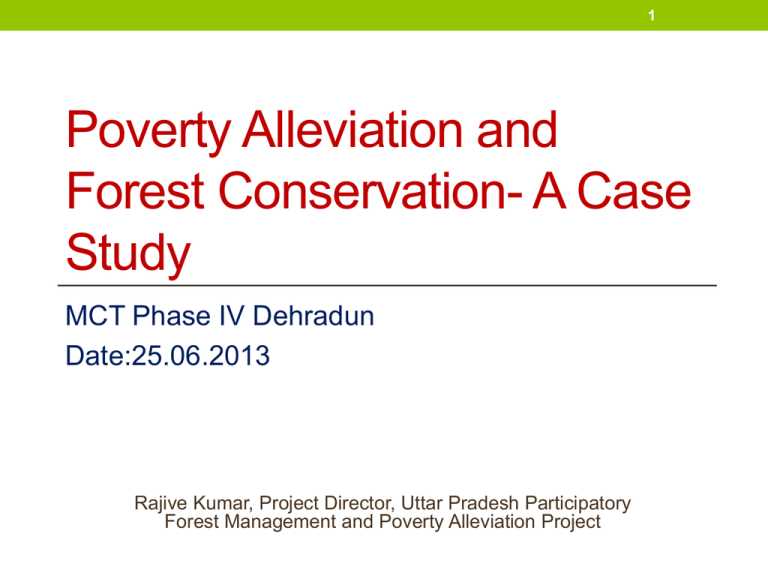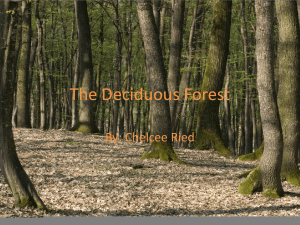Poverty Alleviation and Forest Conservation- A
advertisement

1 Poverty Alleviation and Forest Conservation- A Case Study MCT Phase IV Dehradun Date:25.06.2013 Rajive Kumar, Project Director, Uttar Pradesh Participatory Forest Management and Poverty Alleviation Project Issues about Poverty and Forest Conservation • The rural poor often depend on forests for a wide range of natural resources and ecosystem services essential for their well-being, and are therefore potentially affected by its degradation. • Against this backdrop, conservationists, development practitioners and policy makers often have differing opinions on how—and whether—to link forest conservation with poverty reduction. • Despite the promises of conservationists that they can deliver green sustainable development, around the world extreme rural poverty continues to show a disturbing correlation with the richest forests. • Natural riches, however well protected, do not translate into better lives for the most vulnerable. Indeed, often those who live closest to nature seem to gain the least from its protection. Indeed, the linkages between forest and poverty are much more complex and dynamic that often assumed. 4 Exploring potential of forests • Forest largely viewed as natural capital but they also add to • Financial Capital: Income from forest • Human Capital: Improved food security, agriculture. • Social Wellbeing: • Forest provide non material goods that contribute to livelihood by enhancing social and human capital. • Forestry initiatives that support • access to resources, • participatory decision making and • equity assist in increasing well-being specially that of the poor 5 Exploring potential of forests More than 1.6 billion people in the world depend to varying degrees on forests for their livelihoods. Worldwide, forest industries provide employment for 60 million people. Some one billion people depend on drugs derived from forest plants for their medicinal needs (World Bank, 2001) Fuel wood continues to be vital for many poor producers and consumers. Bulk of rural households in developing countries use firewood as domestic source of energy. Firewood markets share important pro-poor features with other NTFPs. 6 Exploring potential of forests Of the 68 million tribal population of India, 50% still depend on the forest resources for various livelihood requirements viz., food, fodder, medicine, small timber and variety of other NTFPs (Bhattacharya and Hayat, 2004) In India, over half of its forest revenues and about 70% of export income is contributed by NTFP (Shekhar et al., 1993) The enterprise supports about 10 million people in the cottage industry of rolling the final product. NTFP collection accounts for 1063 million person-days (2.9 million persons years) of employment in India 7 Exploring potential of forests Among the Non-Wood Forest Products (NWFPs), tendu leaves (leaves of Diospyros Melanoxylon) used as wrapper for making bidis (country cigarettes) are the most important. The importance of forest product income is usually more in the way it fills gaps and complements other income, than in its absolute magnitude or share of overall household income (Byron and Arnold, 1999) Thus forest has large potentials for livelihood. Forest has also large potential for gainful employment. 8 THE GREATEST OF EVILS AND THE WORST OF CRIMES IS POVERTY George Bernard Shaw 9 Poverty scenario in India – Poverty is more than just being economically weak or having a low income. It involves broader deprivation of well-being and quality of life, including social isolation and powerlessness. - Narayan et al., 2000; Sunderlin et al., 2005 10 Link between Forest and Poverty The state of forests is actually as much as threatened by wealth as by poverty. Poverty is a cause of forest loss. Forest loss contributes to maintain or even increase poverty. This implies that economic development and poverty reduction should help to improve forest condition, and Development of forest resources and improvement in forest conditions can be an important vehicle for poverty reduction. 11 Link between Forest and Poverty People dependent on forest for their livelihood : Around 350-400 million No. of villages located in and around forest : 1.73 Lakhs About 40% of poor people of India live in forest fringe villages. Strong correlation between the tribal concentrated areas, forest and poverty. 12 How to Link Conservation With Poverty Alleviation • Forest management together with poverty alleviation • • • • • programmes. Involve communities in decision making. Livelihood Security Enhancement and Income Generating Activities. Conservation strategies must be linked with livelihood. Issue of benefit sharing. Non forestry Income generating activities should be promoted. With this in background we have a JICA assisted project in UP. 13 A brief on Uttar Pradesh Participatory Forest Management and Poverty Alleviation Project 14 FORESTS ON THE ROAD MAP OF THE DEVELOPMENT OF THE STATE Enhancement of forest and tree cover from existing 9.26% of the State’s geographical area to 20% by the year 201920 would not only fullfil an obligation emanated from National Forest Policy but also provide a launching pad for the development of the State in terms of production of renewable resources in shape of timber, NWFP; employment generation, equity, social justice ,sustained supply to industries like paper and pulp wood and other timber based industries. The enhancement in tree cover and improvement of forest would also help the State in contributing to nullify ill effects of climate change by providing the tree cover as a sink against the noxious pollutants. 15 Logo of the project Project area 16 Project Goals • Participatory rehabilitation and management of degraded forests. • Enhancement of livelihood of local people 17 18 Project Objectives • To restore degraded forest and to augment forest resources. • To secure sustainable forest management by improving Forest administration, Community organization and other stake holders. • To conserve and better manage the wild life. • To improve the income of target forest dependents and their livelihood options. 19 Project Approach There are four approaches to be followed to achieve the project goals: Participatory forest management by JFMC/ EDC together with UPFD formulating micro-plans; More emphasis on NWFP and fodder grasses and establishing benefit-sharing mechanism to support livelihoods and incomes Focus on village-level micro-enterprises to be managed by JFMC/ EDC/ SHG; and Capacity building 20 Project Components Preparatory Work Institutional Arrangement Demarcation, Survey & Mapping Supporting Comp. Soil Survey Site Selection Preparation of Guidelines, Manuals & Handbook Main Component Supporting Comp. Forest Area Development (JFM Mode) Survey & Research Forest Area Development (Non-JFM Mode) Communication & Publication Wildlife Conservation & Management Institutional Strengthening Capacity Building Of JFMC/EDC/SHG Community Development & Livelihood Improvement Monitoring and Evaluation Phase-out/Phase-in Work Consulting Services 21 Institutional Arrangement for UP-PFMPAP EMPOWERED COMMITTEE Finance Department Fund Chairperson: Chief Secretary Through Budgetary allocation Advise PROJECT IMPLEMENTING Unit (PMU) (Autonomous registered society) Governing Body Chairperson: PS, Forests Vice Chairperson: PCCF Member Secretary: CPD Forest Department Project Management Consultant (PMC) Office of PCCF HEADQUARTER Chief Project Director: APCCF/ CCF As grants Zonal Office [CCF] Oversight responsibility Resource Organisations District Level Project Advisory Committee NGO Support Organisations Circle Office [CF] Divisional Management Unit (DMUs) Within DFO office Implementing organizations JFMCs Field Management Units (FMUs) Within RO office SHGs EDCs Partner NGOs 22 What make this Project different MicroPlanning FOREST USER GROUP Wetland Notification of the JFM area Forest Village Non-Natural Resource base Natural Resource base Forest Resource SHG SHG base (NWFP) SHG Moderately Dense Forest JFMC Dense Forest SHG Open/ degraded Forest Participatory M&E (Social Audits) JFMCs EDCs Total No. of Beneficiaries 96,000 22,400 118,400 Ground of Estimation* 800 JFMCs x 120 household (HHs) 140 EDCs x 160 HHs Forest Department 23 Project Cost No. 1 2 3 4 5 6 7 8 9 10 11 12 13 14 15 16 17 18 19 20 Component Cost (Rs. Million) 32.0 417.9 102.1 Preparatory Works Institutional Strengthening of PMU/DMUs/FMUs Capacity Building of NGO/JFMC/EDC/SHG JFMC/EDC Community Development and Livelihood Improvement Departmental Forest Development and Management JFM Forest Development and Management Wildlife Conservation and Management Item 4 and 6 Survey and Research Communication and Publication contributes around Monitoring and Evaluation 45% of the total cost Phase-out/phase-in Works Sub-total (Direct Cost) (No.1~11) Administration Cost Sub-total (No.12+13) Price Contingency Sub-total (No.14+No.15) Physical Contingency Consulting Services Tax and Duties Grand Total (No.16~19) % 0.6% 7.5% 1.8% 827.6 14.6% 717.0 1,701.2 44.6 41.2 43.5 32.5 0.0 3,959.6 687.0 4,646.6 225.0 4,871.6 204.7 293.5 209.0 5,578.8 12.9% 30.5% 0.8% 0.7% 0.8% 232323 71.0% 12.3% 83.3% 4.0% 87.3% 3.7% 5.2% 3.7% 100.0% 24 Expected Benefit Project Component Forest Development and Management Project Activity Timber Production Fuel Wood Production NTFP Development Benefit Stumpage value of Teak (Tectona grandis) Stumpage value of Sal (Shorea robusta) Stumpage value of Sisso (Dalbergia sissoo) Production of Fuel Wood Production of Khair (Acacia catechu) Production of Amla (Embilica Officinalis) Production of Chironji (Buchanania lanjan) Production of Salai (Boswellia serrata) Production of Harra (Terminalia chebula) Production of Bamboo (Dendrocalamus strictus, etc.) Fodder Development Production of Grass Forest Development Fire Damage Prevention and Management Carbon Sequestration Soil Conservation Wildlife Conservation Ecotourism Ecotourism and Management Development Community Development IGA by SHGs and IGA and Livelihood SHG Consortium Development Total 74% share of NTFP and 12% share of IGAs by SHGs is expected Value (Rs. mil.) 1,988 446 330 987 2,648 9,050 2,789 261 10,087 9,472 323 212 675 712 482 5,649 46,109 25 Key Actors at Implementation level FMU Partner NGO Animator JFMC/ EDC Community 26 JFMCs/ EDCs – How are they located? 27 JFMC/ EDC – emerging as Institutions • JFMCs are created under UP Village Forests Joint Management Rules, 2002 that ensures • Notification of ‘village forest’ as defined in section 28 of Indian Forest Act, 1927 • Constitution of Forest User Group (FUG) • JFMC to sign agreement/ MOU with the UPFD to jointly manage the village forest • Perform functions and duties, and exercise powers as defined in JFM Rules of year 2002 • EDCs are created under resolution of Government of Uttar Pradesh made in year 1999 28 Additional Features under the project • Registration under Societies Act, 1860 • Notification of village forest (with site demarcation and erection of boundary pillars) and signing of MOU with UPFD • Allocation of forest land for plantation purpose having forest type in category of a) very dense forest, b) moderately dense, and c) open degraded and scrub forest • Nomination of Executives officers (President, Treasurer, Book keeper, Secretary) • Constitution of eight Working Groups • Membership fee collection on annual basis • Self-Help Groups (SHGs) as sub-group of FUG or forest-dependent family to be constituted for income generation 29 Expectations from JFM/ EDC • Now JFMC are expected to function as autonomous institutions, and as partner to the UPFD • However, eco-development has focus on sustainable management, development and utilization of forest & its resources. 30 How Micro Plan is visualized in the project? • Micro-plan under the project would have two dimensions: • Participatory Management of village forest under JFM 2002 Rules and MOD provisions • Community Development and Livelihood Improvement It is also important to know and connect Micro-Plan with Working Plan • Under which Working Circle notified “Village Forest” comes, and • What prescription is made by the Working Plan officer 31 • Thus, important elements of Micro-Plan are • Vision of JFMC/ EDC for next five-years and beyond as registered society • Plan to execute activities envisaged under the project • Convergence and dove-tail plans (through District-level Advisory Committee - DLAC) • Activities for which funds are available under the project for project duration • Alternate source of fund to realize activities not supported by the project but needed and high on priority of the community • Exit Policy and fund mobilization strategy beyond project-life 32 How could Micro-Plan be evolved in this? Built capacities of JFMCs/ EDCs Research’s Inputs – Work norms & JFM / NWFP models Baseline of Village Forest – stocks/ resources MICRO PLAN Technical guidance & support by UPFD (under MOU) Site demarcated and Base map 1:5000 scale (digital) Baseline: Socioeconomic & resource utilization 33 FUG meeting in Bhujpur JFMC, Sumerpur, Hamirpur Seed showing in Village Forest area by FUG in village Sahira, Lalganj, Mirzapur 34 IS LIFE POSSIBLE WITHOUT LIVELIHOOD? What is there for livelihood in the project? 35 Definition of Livelihood • A livelihood comprises : • the capabilities, • assets (including both material and social resources) and • activities required for a means of living. • A livelihood is sustainable • when it can cope with and recover from stresses and shocks and • maintain or enhance its capabilities and assets both now and in future,while not undermining the natural resource base. - Chambers and Conway, 1992 Income Generating Activities through SHGs Forest based /Natural Resource Based/ Non-Natural Resource Based IGA/ Micro-enterprise activities Formation and Funding of 2680 SHG/ Micro-Enterprise Marketing Research and Support by resource organizations (to identify, development of the product profile and non-destructive harvesting techniques, business plan and marketing strategies) 36 SHG Formation • Internal saving and book keeping (Commonly known as Rotating Saving and Credit activities). • Financial support of Rs. 1.1 lac (Rs 1 lac seed fund and Rs10000 as support fund to each SHG) • Till date 1664 SHGs have been formed against 2680 and internal savings started. • 579 SHGs have been funded by the Project till date. 37 38 IGA Training in Kanwa JFMC, FMU Babhni, Renukoot Demonstration of nursery technique of Satawar & Kal megh Map of Dhauha village forest area, FMU Chunar, Mirzapur 39 Discussion on Business Plan with SHGs in Naugarh, Kashi by PMC team SHG grading in Sonah EDC, Dudhwa, Dudhwa 40 SHG members (Trainees) field visit to Udyamita Vikas Sansthan, Chitrakoot IGA Training in Kanwa JFMC, Babhni, Renukoot 41 Nursery done by Jai hind SHG under IGA; JFMC Baghnari, FMU Gurma, Kaimur Consensus Building in Village Khadiya, FMU Motipur, Katarniaghat 42 Lac culture Tasar Resource Organizations' Details Name of Resource Organization Task Allocated State Forest Research Institute, M.P. Jabalpur State Forest Research Institute, M.P. Jabalpur Development Alternatives, New Delhi NTFP Resource Assessment and Development Harvesting and Post-Harvesting Technology of NTFP Market Research, Business Plan Development, Product Profiling, Product Development Protocol, Trade Linkage and Networking for potential IGA/SME NTFP Marketing including Certification Indian Institute of Forest Management, Bhopal 44 Livelihood Security Enhancement • Also popularly known as Entry Point Activities. • Basically for the development of village. • More targeted for socio-economic weaker section of village. • More emphasis on JFMC building construction. • Other popular activities are tent house, handpumps, wells. • Support of Rs.1.80 lacs. 45 Solar light installed through Convergence, Musahidpur EDC, Chakiya, Kashi Construction of well (EPA), Goderkhurd JFMC, Patehra, Mirzapur 46 FUG listing on House wall, Kevatam JFMC, Ramgarh, Sonbhadra Production Kit distribution, Exposure visit at Renukoot Division 47 JFMC Office Building, Bihuni Khurd JFMC, Rath, Hamirpur 48 Timber, Bamboo and Tendu-patta Benefit Sharing Income = Sale Proceeds – (Actual Expenditure + Overhead expenses) Situation 2: Large scale felling due to calamities Situation 1: Regular course 50% Income JFMC 10% Income 50% Income or one lakh UFPD JFMC Situation 3: In case of Bamboo only if UPFC opts out Total sale proceeds Royalty by JFMC Balance Income UFPD JFMC UFPD 49 Benefit Sharing…2 Income = Sale Proceeds – (Actual Expenditure + Overhead expenses) NWFP other than Tendu-patta and Medicinal plants 100% Income JFMC Token money by JFMC UFPD Medicinal Plants (Raw form) 100% Income JFMC Token money UFPD 50 Budgetary Flow • Budgetary flow to JFMC/ EDC would be strictly divided with establishing two different accounts in a JFMC/ EDC village – • JFMC Account (for forestry work) • Village Development Fund (VDF) (for village development work) • This has been created to avoid probable mixing-up of expenditure between forestry work and village development work. • Different sources and management/ utilization has been suggested to the two accounts 51 Budgetary flow model for JFMC DMU Funds during project period JFMC Account (For Forestry Work) 1/4th Cash fines for illegal felling Grazing Fee Benefit Share of JFMC 3/4th VDF Account (For Village Development Work) Returned principal & Interest from SHG Loan SHG SHG SHG 52 Utilization of Income by JFMC Income for various sources 1/4th Benefit share / earnings JFMC Account (For Forestry Work) 3/4th Benefit share / earnings VDF Account (For Village Development Work) 1/4th Benefit share / earnings for each Seed Money FUG Dividend Community Development AR-CDM initiative in UP PFMPAP • India is a signatory to Kyoto Protocol 1992 • AR-CDM is a tool to get CER Credits to communities • • • • (JFMCs) Provision of Study within project area for registration of AR-CDM Projects with United Nation Framework Convention on Climate Change (UNFCCC). TERI has been selected for this study and work is in progress. Survey of the village forests of first batch JFMCs has been completed and around 5000 ha land has been identified for submission of Project Design Document (PDD) to UNFCCC through MoEF 10 Prior Consideration Forms for 10 PDDs have been submitted to UNFCCC 53 Monitoring and Evaluation GIS Density Improvement Analysis: Through change detection analysis (comparison) of satellite imageries (LISS IV and Carto sat I data) of 20 forest divisions. Image based maps have been completed for 04 divisions of Vindhyanchal Region and 02 divisions of Terai 02 div of Bundelkhand SO-REN-Baghadu-I-Karri-12 Satellite Imagery Density Classification Vegetation Analysis Vegetation Type 2009-2010 Area (Ha) % Area Scrub 0.44 0.25 Open Dense 1 5.59 3.22 53.72 30.90 High Dense 1 114.10 65.63 Total 173.85 100.00 Medium Dense 2 Padri Khurd - 2004 State ARM 19-20 September 2012 Padri Khurd - 2010 57 MIS Development • The project is developing web based information flow through inhouse development of MIS-10 modules. • All major modules rolled out. • All Financial Transactions of PMU are online from FY 2011-12. GIS and MIS interface • All physical activities will be evaluated on GIS based platform for pre-project and end term (spatial and temporal level) including forest type stratification and growing stock estimation • All villages will be covered with MIS and GIS linkages. • In the first stage the web based MIS is being developed for Divisions. After its evaluation it will be developed for range level. This can be adapted for use in the department. 61 M&E mechanism • MIS: Physical and Financial Reporting (every month on prescribed formats/ template) • Use of GIS for spatial analysis • Performance Indicators • Annual Work Plan (drawn on the basis of implementation schedule vis-à-vis scope defined in the TOR) • Reviews (meetings, field visits) • Ad-hoc Studies • Surveys 62 Project Information Reporting Plan Planning Physical Financial Socio-economic Training Amount allocated Amount sanctioned Expenditure details Details of procurement Inputs from PMU Status of forest Plantation activitiy Groundwater level Soil erosion Wildlife conservation JFMC members Income level Availability of fodder Milk yield & production Crop yiled & production Income from forest (NWFP) MIS GIS Others Monitoring Progress in plantation activity Area wise species planted Progress in water/soil conservation activities Monitoring of wildlife conservation measures Growth of planted trees Issues concerning implementation Suggestions/ Feedback Monitoring of activities of institutions Alternative livelihood development activities People’s perception toward forest Active participation of villagers in JFM activities Availability of fodder Reports Maps Training schedule List of participants attended Timely completion of training Feedback Details of procurement Expenditure details Spatial Attribute Forest legal boundary map Forest division map Village boundary map JFM location map Land use / land cover map Maps Inputs from FTI 63 Social audit in Bargawan JFMC, Jugail, Obra Social Audit in Bajaddi JFMC, Shankargarh, Allahabad 64 Lessons learnt • Provide space to all stakeholders in decision making including planning, implementation and monitoring • Poverty alleviation could not be merely achieved through employment generation but by empowering community as a whole • Forest alone can not sustain the livelihood of people. • Handholding and guidance for a longer period • Enabling Policy environment and uniform policy regime • Rules and Regulations including amending laws to facilitate processes 65 • Community centric decision making • Partnerships • Inter-sectoral linkage and Convergence • Transparency and Accountability • Institutional arrangement coherent with existing statutory bodies for local governance to avoid overlap and conflicts • Post project budgetary support • Continuity of Policy 66 A BIRD IN THE SKY DOES NOT SING BECAUSE IT WANTS TO WIN A MUSICAL COMPETITION OR SOMEONE HAS TOLD HER TO SING It sings because it has discovered a freedom song inside its own heart! 67 Thanks for your kind attention!








